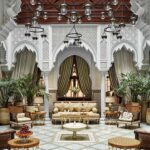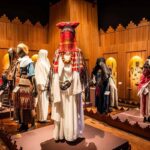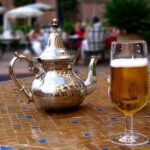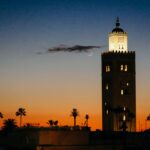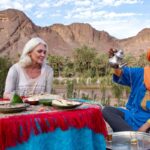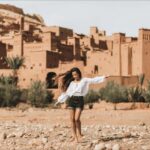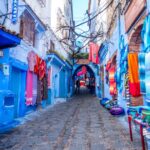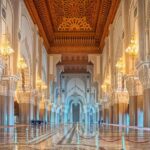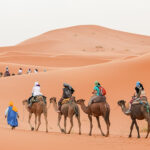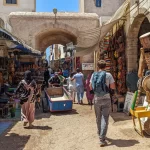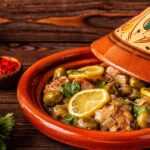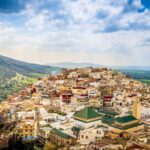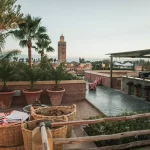Marrakech, a city that whispers the tales of time, invites travelers to immerse themselves in its heart—the souks. These markets, more than mere places of commerce, are the lifeblood of the city, pulsating with the vibrant rhythms of daily Moroccan life. Imagine a world where every sense is awakened: the rich aroma of spices fills the air, the vivid colors of artisan crafts dazzle the eyes, and the symphony of sounds from bargaining voices to the call to prayer envelops you. This is Marrakech, a city where past and present dance together in the labyrinthine alleys of its souks.
The souks of Marrakech are not just markets; they are a journey through the soul of the city. Each turn within these bustling corridors reveals a new chapter of history, a fresh palette of colors, and a unique story told by the artisans themselves. These markets are a place where the heart beats stronger, fueled by the passion of the people and the beauty of their crafts.
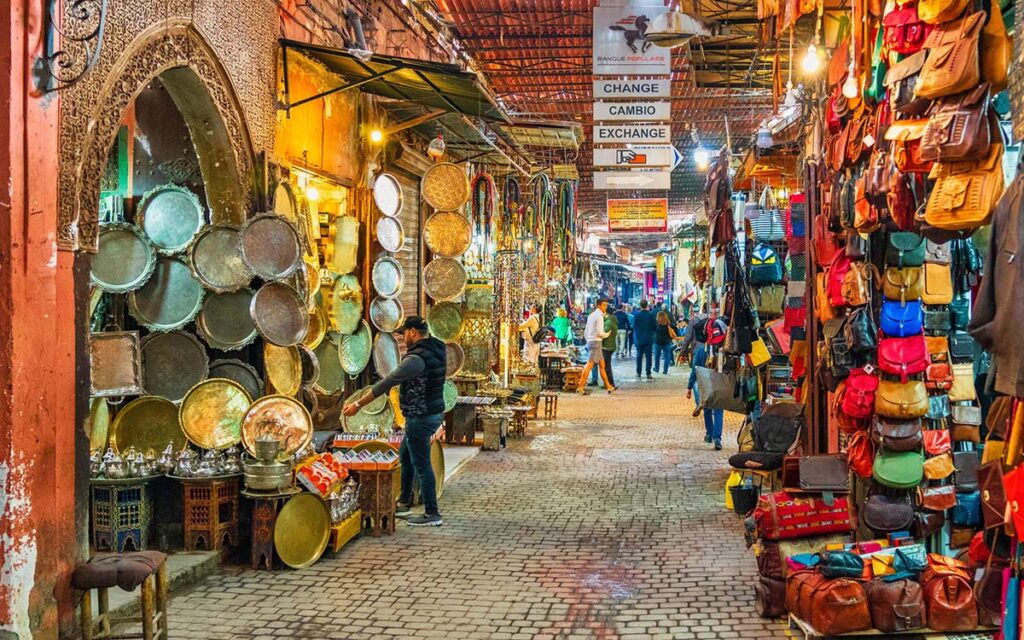
Table of contents
The Medina: A Portal to the Past
Nestled within the ancient walls of Marrakech lies the Medina, a historic district that serves as the vibrant heart of the city. As you step through its grand gates, you are stepping into a world where history breathes in the stones underfoot and in the air around you. The Medina is a tapestry of life, woven from centuries of trade, tradition, and cultural exchange.
Historical Significance
The Medina of Marrakech, a UNESCO World Heritage site, stands as a testament to the city’s rich historical past. Founded in the 11th century by the Almoravids, it was conceived as a political, economic, and cultural center of Morocco. The ancient walls that encircle the Medina today tell tales of a time when Marrakech was a flourishing imperial city, playing a pivotal role in the trans-Saharan trade.
Architectural Marvels
The architecture within the Medina reflects the diverse influences that have shaped Marrakech over the centuries. From the red sandstone walls that gave the city its nickname “The Red City” to the intricate tile work and carvings adorning the many palaces and mosques, the Medina is a feast for the eyes. Each gate into the Medina, such as the iconic Bab Agnaou, is not just an entry point but a historical monument, showcasing the exquisite craftsmanship of Moroccan artisans.
Life within the Walls
Today, the Medina remains the throbbing heart of Marrakech, alive with the buzz of markets, the calls of vendors, and the scents of traditional Moroccan disheswafting through the air. It is here, amid the narrow, winding alleyways, that you find the soul of the city. The souks of the Medina, each dedicated to a different craft or product, offer a glimpse into the lives of the locals, where tradition and modernity coexist seamlessly.
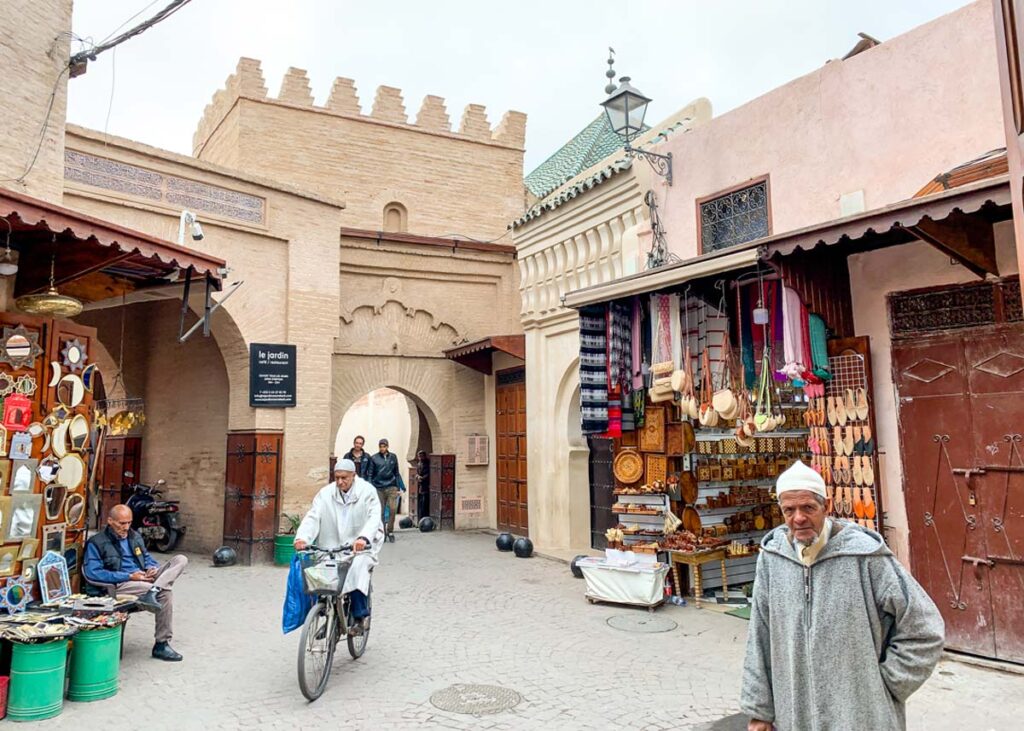
Navigating through the Medina can feel like traversing a living museum, where every corner holds a piece of history and every face has a story. The vibrancy and chaos of the souks, the serene beauty of hidden Riads, and the timeless allure of historic sites like the Koutoubia Mosque and the Ben Youssef Madrasa all contribute to the Medina’s magic.
A Kaleidoscope of Specialized Souks
Embarking on a journey through Marrakech leads you straight to the pulsing heart of the city: the enchanting Jemaa el Fna Square. From here, a labyrinth of souks (markets) unfolds, inviting you into a world where every turn reveals a new treasure. Souk Semmarine acts as your gateway, drawing you deeper into the maze. As you wander, the air changes – a burst of colors and scents at Spice Square, the gleam of antiques in Souk el Attarine, the sight of babouches (traditional slippers) signals Souk Smata, and the rich aroma of leather hints you’ve reached Souk el Kebir. Each souk offers a unique slice of Moroccan life and an adventure in its own right.
The Carpet Souk: Woven Histories
In the heart of the Medina, the Carpet Souk unfolds like a vibrant tapestry under your feet. Here, each rug tells a story, woven by the skilled hands of Berber artisans from the Atlas Mountains. These carpets are more than mere floor coverings; they are pieces of art, each pattern symbolizing a part of the weaver’s life or the natural world around them.
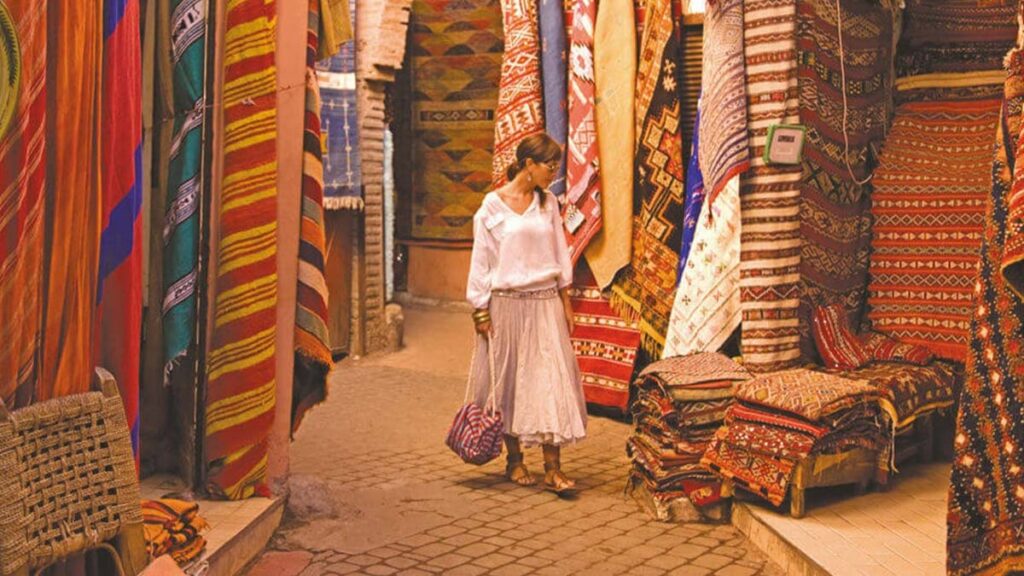
Artisan Profiles
Meet Fatima, a third-generation carpet weaver whose fingers dance across the loom with grace and precision. She shares stories passed down through generations, her rugs a vibrant testament to Berber culture and history. Her stall in the souk is a riot of color and pattern, each piece inviting you to touch, to feel the story woven into its fibers.
Shopping Tips
When shopping for a carpet, look for uniqueness in design and quality of material. Bargain respectfully, remembering that you are investing in a piece of art that took months to create. Fatima advises, “Look for the soul of the rug. It will speak to you if it’s meant for your home.”
The Leather Souk: A Legacy of Craftsmanship
The scent of tanned leather leads you to the Leather Souk, where artisans have been crafting goods for centuries. Marrakech’s tanneries are among the oldest in the world, and the leather goods found here are a testament to the enduring quality and craftsmanship.
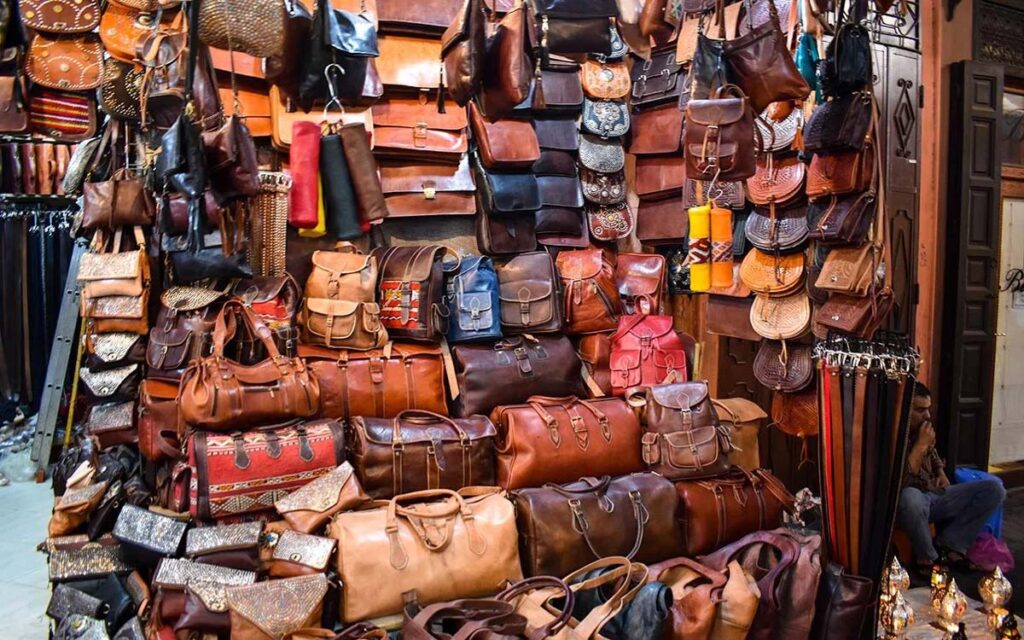
Artisan Profiles
Abdel, a leather craftsman, shapes a piece of supple leather into a traditional Moroccan pouf. He explains the tanning process, a tradition inherited from his ancestors. “Each piece of leather tells a story of transformation,” he says, “from raw hide to a beautiful object that can last a lifetime.”
Shopping Tips
Quality leather should feel soft and supple. Inspect the stitching and finish for craftsmanship. Abdel recommends buying goods directly from the artisans when possible, to ensure authenticity and support local craftsmanship.
The Spice Souk: A Feast for the Senses
Next, the Spice Souk envelops you in a cloud of aromas. Here, mounds of spices in every hue create a colorful mosaic, each adding its own flavor to the Moroccan culinary palette.
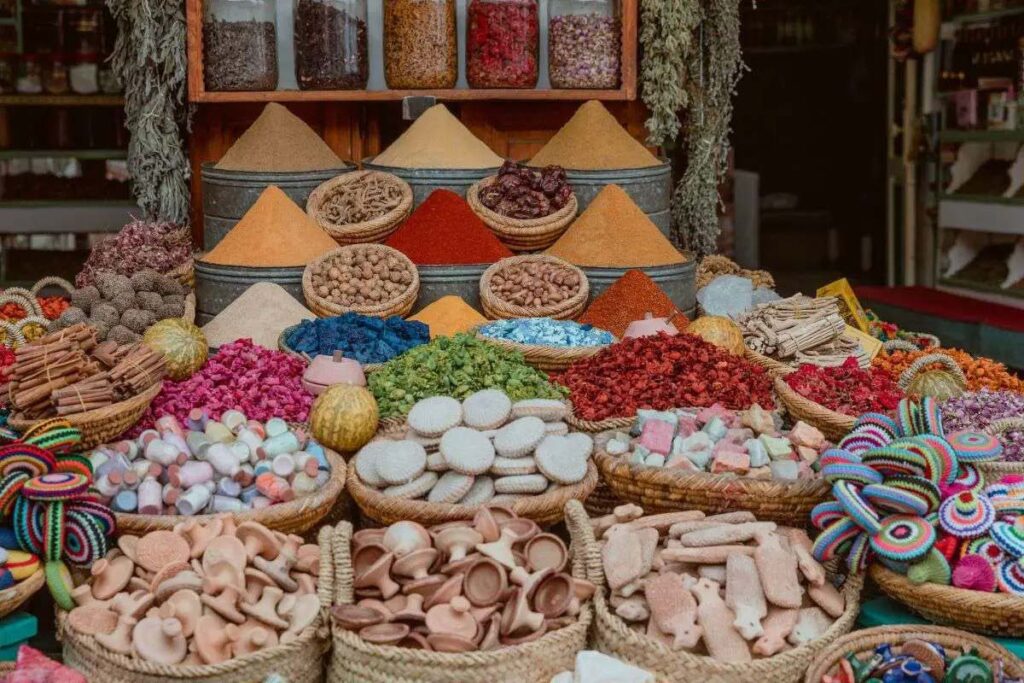
Artisan Profiles
Nadia, a spice vendor, guides you through her array of spices, from the fiery heat of cumin to the sweet warmth of cinnamon. She shares recipes passed down from her grandmother, each spice a key to unlocking the secrets of Moroccan cuisine.
Shopping Tips
Nadia suggests buying spices in small quantities to ensure freshness. Look for vibrant colors and strong aromas—signs of good quality. “Spices are the heart of Moroccan cooking,” she smiles, “add them with love.”
The Copper Lantern Souk: A Glow of Artistry
As twilight descends upon Marrakech, the Copper Lantern Souk begins to glow with the warm light of masterfully crafted lanterns. Here, the air is alive with the soft tapping of metalwork, as artisans transform sheets of copper into intricate lanterns and lamps that cast mesmerizing patterns of light.
Artisan Profiles
Meet Youssef, a lantern artisan whose family has been shaping copper into light for generations. In his shop, the air is filled with the glow of lanterns in countless designs, each piece a testament to the skill and creativity of Moroccan craftsmen. Youssef’s hands move with precision and care, as he etches delicate patterns into a copper sheet, a dance of light and shadow born from his chisel.
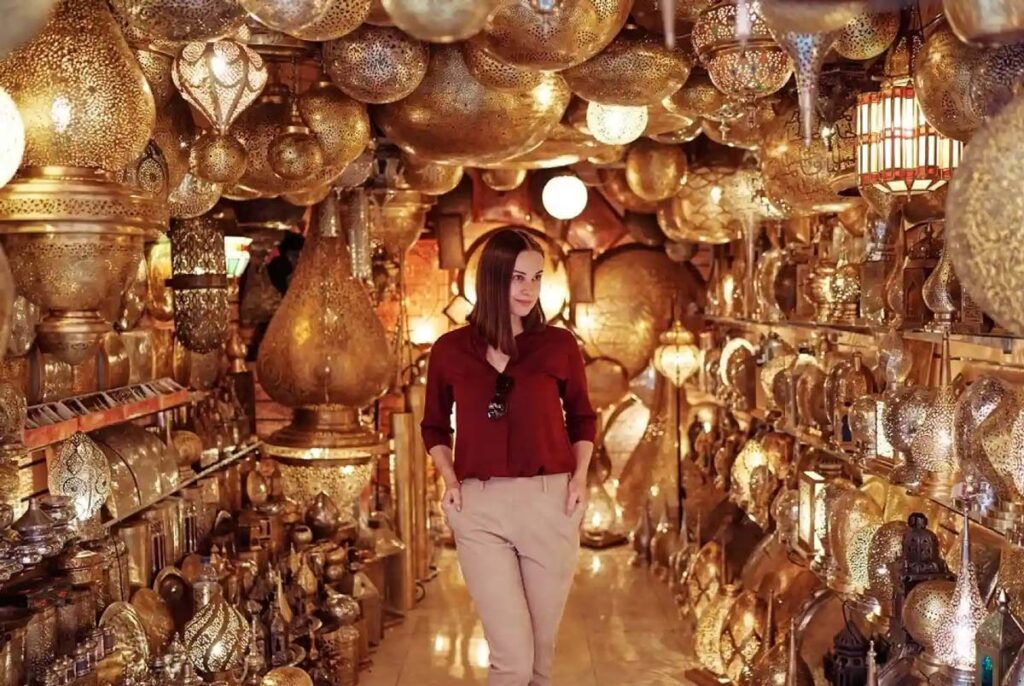
“Each lantern carries a story,” Youssef shares, his eyes reflecting the flicker of candlelight. “They’re not just to illuminate the night but to adorn the soul of a home, to bring warmth to the heart.”
Shopping Tips
When selecting a copper lantern, consider the craftsmanship—look for precision in the etching and a uniformity in the metal’s patina. Youssef advises, “Choose a lantern that speaks to you, one whose light dances in a way that captures your imagination. It’s not just a piece for your home; it’s a piece of Marrakech.”
Embracing the Souk Experience
As we journey through the specialized souks, the narrative of Marrakech unfolds through its artisans, their crafts, and the vibrant markets that pulse at the city’s heart. Each souk offers a unique window into the soul of Morocco, inviting explorers to immerse themselves in the rich tapestry of culture, history, and tradition.
The souks of Marrakech are not merely places to shop; they are sanctuaries of heritage, showcasing the enduring spirit of Moroccan craftsmanship and the warmth of its people. As you wander through these markets, let yourself be guided by the stories they tell, the colors they reveal, and the life they breathe into the ancient city of Marrakech.
Navigating the Maze: The Art of Souk Exploration
The souks of Marrakech, with their narrow alleys and endless turns, can seem like a maze to the uninitiated. Yet, there’s a method to the madness, and part of the charm lies in learning to navigate these winding paths.
Orientation and Landmarks
Begin your exploration with a map, but don’t be surprised if you find it only somewhat helpful in the densely packed Medina. Instead, use landmarks like the towering minaret of the Koutoubia Mosque or the bustling square of Jemaa el Fna as your compass. The flow of people can also guide you, leading you through the most traveled paths and into the heart of the souks.
Tips for Not Getting Lost
• Follow the flow: Let the natural current of foot traffic guide you through the souks.
• Landmark Navigation: Keep an eye out for unique shops or features as points of reference to navigate back.
• Ask for directions: Locals are generally helpful, and shopkeepers can provide guidance. However, be aware that some may lead you to their shops as part of their assistance.
Marrakech Souk Experience: More Than Just Shopping
Visiting the souks is about more than just shopping; it’s about immersing yourself in Moroccan way of life and culture. Here are ways to fully embrace this unique experience.
Cultural Engagement
• Tea Invitations: Accepting an invitation to have tea with a shopkeeper can offer insight into Moroccan hospitality and might lead to fascinating stories and friendships.
• Learn Basic Arabic or French Phrases: Communicating, even simply, in the local language can enrich interactions and show respect for the culture.
Ethical Shopping and Bargaining
Bargaining is an integral part of the souk experience, but it’s essential to approach it with respect and understanding.
• Fair Bargaining: Start by offering about half of the asking price, working your way up to a mutually agreeable price. Remember, this is part of the culture and is expected by vendors.
• Support Artisans: Whenever possible, buy directly from artisans. This not only ensures authenticity but also helps sustain traditional crafts.
Practical Advice for Souk Adventurers
To make the most of your souk experience, consider these practical tips.
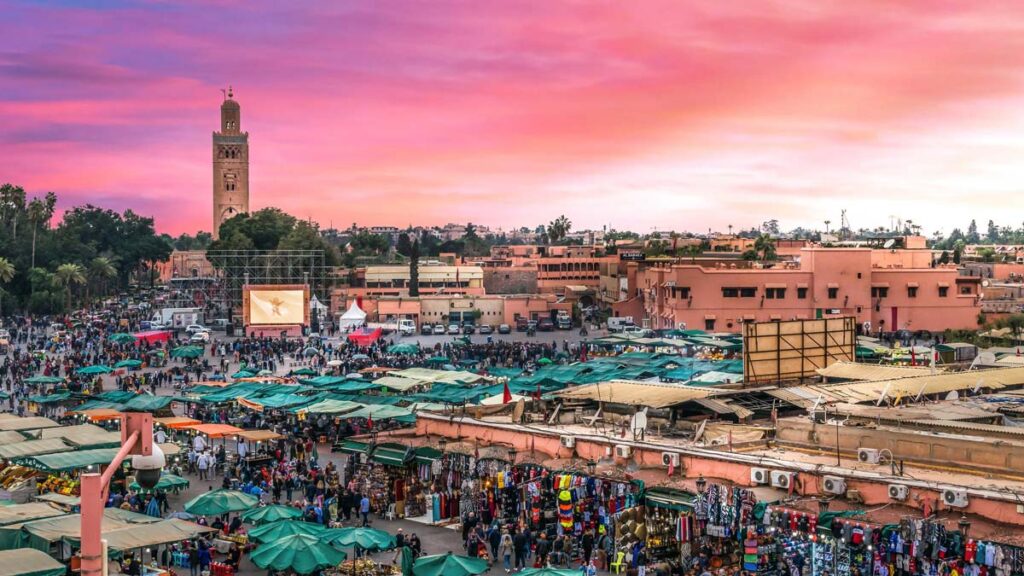
What to Wear and Bring
• Comfortable Footwear: You’ll be walking on uneven surfaces.
• Light Layers: The souks can be cooler in the morning and evening, hot during the day.
• Water and Snacks: Stay hydrated and energized during your exploration.
• Cash: Many vendors do not accept credit cards, and cash offers a better position for bargaining.
Safety and Etiquette
• Be Mindful of Your Belongings: Keep your wallet and phone secure, as crowded places can attract pickpockets.
• Respectful Photography: Ask for permission before taking photos of people or their goods.
• Patience and Politeness: Crowds and bargaining can test your patience, but a polite and friendly attitude goes a long way.
The Souks of Marrakech – A Journey of Discovery
The souks of Marrakech offer a journey like no other, through the vibrant heart of Moroccan culture and craftsmanship. From the intricate designs of copper lanterns to the rich history woven into each carpet, the souks are a place of discovery and connection. By embracing the experience with an open heart and mind, visitors can find more than just souvenirs; they uncover stories, friendships, and memories that illuminate the soul of Marrakech.
For those looking to delve even deeper into the heart of the city, a Marrakech walking tour can be an invaluable addition to your adventure. Guided tours can offer nuanced insights into the history, architecture, and traditions that define the Medina and its souks. With a knowledgeable local guide, you can explore hidden gems, learn about the cultural significance behind the crafts, and hear stories that breathe life into the stone walls and winding alleys.
Embarking on a Marrakech walking tour is more than just a sightseeing experience; it’s an invitation to engage with the city on a personal level, uncovering the layers of history, culture, and artistry that make Marrakech a truly magical place. Whether you’re navigating the bustling lanes of the souks, admiring the serene beauty of a hidden riad, or soaking in the lively atmosphere of Jemaa el Fna, each step is a step deeper into the heart of Morocco. Welcome to the souks of Marrakech, where every step is a story, and every purchase a piece of a centuries-old tapestry, waiting to be discovered.







